
Hanuman Jayanti, an auspicious Hindu festival that commemorates the birth of Bhagwan Hanuman, the epitome of devotion, strength, and selfless service, will be celebrated with great fervor and spiritual enthusiasm on
Saturday, April 12th.
Hanuman Jayanti is a sacred and spiritually significant festival that unites devotees worldwide in honoring Bhagwan Hanuman, the epitome of devotion (bhakti), strength (bala), and righteousness (dharma). As the selfless servant of Bhagwan Rama, His unwavering loyalty, boundless courage, and divine wisdom continue to inspire millions. Revered as Anjani Putra, Vayu Putra, and Sankat Mochan, He is the ultimate protector and guide, helping devotees overcome obstacles, dispel fears, and cultivate inner strength.
This festival symbolizes a very powerful spiritual awakening, invoking Hanuman’s divine presence through prayers, fasting, and devotional surrender. It is a day is marked by grand recitations of the Hanuman Chalisa, elaborate pujas, abhishekas (ritualistic consecrations), and yajnas (sacred fire offerings) in temples and homes alike. Devotees observe fasts, chant Hanuman’s glories, and participate in processions, filling the air with the soul-stirring chants of Jai Bajrang Bali!
Seeking His blessings for strength, wisdom, and protection, devotees immerse themselves in His divine energy. As we approach Hanuman Jayanti in 2025, let us delve into its sacred rituals, profound significance, and transformative power, celebrating one of the most revered festivals in Hinduism.

Hanuman Jayanti 2025 Festival Date, Time, Muhurat & Tithi
Hanuman Jayanti will be observed on Saturday, April 12th, 2025.
Purnima Tithi (Full Moon Day) of the Chaitra month in the Hindu lunar calendar. This corresponds to the 15th lunar day (Purnima) of the Shukla Paksha.
Key Timings for Hanuman Jayanti 2025:
Purnima Tithi (Full Moon Period):
- Begins at 03:21 AM on April 12th, 2025 (IST)
- Ends at 05:51 AM on April 13th, 2025 (IST)
Devotees perform special prayers and rituals during the Purnima Tithi to honor Bhagwan Hanuman's birth. It's advisable to consult local temple authorities or a reliable Panchang (Hindu calendar) for specific Puja Muhurat (auspicious timing) in your area, as the above timings are based on Indian Standard Time (IST) and these can vary based on your location.
Hanuman Jayanti Sunrise Times
It has long been believed that Bhagwan Hanuman was born at sunrise. On Hanuman Jayanti day, temples start spiritual discourses at dawn before sunrise and conclude them after sunrise. Please note that Sunrise and sunset vary by region and date due to India's geographical diversity and extension. For exact timings, refer to local astronomical data or consult with local priests.
Regional Variations
Hanuman Jayanti is widely celebrated on Chaitra Purnima, the day Bhagwan Hanuman was born. However, in Tamil Nadu and Karnataka, the festival is known as Hanumath Jayanthi and takes place in the month of Margashirsha (December-January). The differences stem from various traditions and interpretations of Hanuman's birth in different scriptures.
Importance & Significance of Hanuman Jayanti

The term 'Jayanti' originates from the Sanskrit words 'Jaya' (victory) and 'Anta' (end), signifying one who triumphs in the end. It is the feminine form of 'Jayanta', embodying the essence of ultimate victory over adversity. The Mundaka Upanishad emphasizes this through the verse 'Satyameva Jayate'—'Truth alone triumphs'.
Hanuman Jayanti is a deeply revered Hindu festival that commemorates the birth of Bhagwan Hanuman, the embodiment of strength (bala), devotion (bhakti), wisdom (jnana), and righteousness (dharma). Regarded as the greatest devotee of Bhagwan Rama, Hanuman’s life serves as an eternal source of inspiration for those who seek selfless service, fearlessness, and unwavering faith in the path of righteousness. Worshipping Bhagwan Hanuman is believed to bestow protection, remove obstacles, and grant spiritual and physical strength, making this festival a time of immense divine grace and blessings.
Bhagwan Hanuman’s unwavering devotion to Bhagwan Rama during the fierce battle against Ravana’s evil forces exemplifies this principle. He emerged victorious because he stood with Sat (Truth), represented by Bhagwan Ramachandra. The Bhagavad Gita describes the Absolute as 'Om Tat Sat'—the Eternal Truth, and one who follows the path of righteousness and transcendence ultimately prevails. Thus, on Hanuman Jayanti, we honor and worship Hanuman, who embodies victory through devotion, strength, and truth.
According to Hindu scriptures, Bhagwan Hanuman is recognized as an incarnation of
Bhagwan Shiva
, sent to assist Bhagwan Vishnu’s incarnation as Rama in His mission to destroy evil. His birth was divinely orchestrated, as Kesari and Anjana, his earthly parents, were blessed by Vayu Deva (the Wind God), ensuring that Hanuman was born with extraordinary powers. As a child, Hanuman’s divine nature was evident—one of the most famous legends describes how he mistook the Sun for a ripe fruit and attempted to seize it. Alarmed, Bhagwan Surya (the Sun God) sought protection from Indra, who struck Hanuman with his Vajra (thunderbolt), causing him to fall to the ground. This infuriated Bhagwan Vayu, who withdrew air from the world, creating chaos. To appease him, the gods bestowed Hanuman with divine boons, including immortality, immense strength, shape-shifting abilities, and wisdom.
Hanuman’s unwavering devotion to Bhagwan Rama remains the hallmark of his divine existence. His unparalleled dedication and fearless service during the war against Ravana cemented his status as the supreme bhakta (devotee). When Sita was held captive in Lanka, Hanuman delivered Bhagwan Rama’s message, reassuring her of His arrival. In a heroic act, he set Lanka ablaze with his divine tail, displaying his unmatched power. His role became even more crucial when Lakshmana was wounded on the battlefield, prompting Hanuman to lift the entire Dronagiri Mountain in search of the Sanjivani herb to save his life.
Beyond the Ramayana, Hanuman’s divine presence is also acknowledged in the Mahabharata. Although he did not actively participate in the Kurukshetra war, he blessed Arjuna’s chariot by placing his emblem on its flag, ensuring divine protection alongside Bhagwan Krishna (Vishnu’s incarnation). This sacred connection symbolizes Hanuman’s eternal presence as a guardian of dharma and righteousness.
The observance of Hanuman Jayanti is marked by elaborate pujas, recitations of the Hanuman Chalisa and Sundara Kanda, fasting, and grand processions in temples and homes. Devotees seek his blessings for strength, courage, wisdom, and protection from all adversities. As an immortal deity, Hanuman continues to exist in the world, ready to assist those who call upon him with true devotion. Hanuman Jayanti thus stands as a powerful spiritual occasion, reminding devotees of the boundless strength that arises from faith, surrender, and selfless service to the Divine.
History of Hanuman Jayanti
The history of Bhagwan Hanuman has captivated scholars, thinkers, and mythologists worldwide, inspiring deep exploration into his divine origin, extraordinary feats, and eternal presence. Hanuman is considered a manifestation of Bhagwan Shiva, who, eager to partake in the divine pastimes (leelas) of Bhagwan Vishnu, incarnated as Hanuman to serve Bhagwan Rama in his mission to restore dharma. His birth itself was the result of a celestial prophecy—his mother, Anjana, was a celestial being cursed to be born as a Vanara (female ape), and her curse could only be lifted by giving birth to an incarnation of Shiva. This divine connection cements Hanuman’s sacred role as a bridge between Shiva and Vishnu worship.
Hanuman’s first meeting with Bhagwan Rama and Lakshmana took place at Rishyamukha, a fateful encounter that marked the beginning of his eternal devotion to Rama. While most scriptures describe Hanuman as a celibate (Brahmachari), some Southeast Asian versions of the Ramayana, such as the Khmer Reamker and Thai Ramakien, portray him as having a mate, Suvannamaccha, a mermaid princess. This variation reflects regional interpretations of Hanuman’s legend, demonstrating his widespread cultural influence beyond India.
Beyond mythology, Hanuman’s symbolism extends into history and tradition. In Kerala, his figure is carved onto a Kataram, a traditional dagger used by the Nairs in Kalaripayattu (martial arts), signifying his strength and warrior spirit. Above all, Hanuman’s final promise to Bhagwan Rama remains his most profound legacy—he vowed to remain on earth in an invisible form as long as Rama’s name is chanted, glorified, and worshiped. This makes Hanuman immortal (Chiranjivi) and eternally present, ensuring that devotees who call upon him with sincerity always receive his divine protection and blessings.
Stories of Hanuman Jayanti Festival
The following three legendary stories define Hanuman’s divine essence, his childlike innocence, boundless courage, and unparalleled devotion to Bhagwan Rama. Each tale is not just a story but a lesson in faith, strength, and surrender, making Hanuman Jayanti an occasion to connect deeply with the spirit of Hanuman and invoke his blessings for protection, wisdom, and victory over all obstacles.
Hanuman and the Sun – The Child Who Tried to Swallow the Sun

In the divine forests of Kishkindha, where the golden rays of dawn danced upon the treetops, a young Hanuman, brimming with boundless energy, awoke to a mesmerizing sight—the radiant Surya Deva (the Sun God) rising in all his brilliance. To the innocent child, the blazing sphere in the sky appeared as a delicious ripe fruit, tempting him beyond measure. With the swiftness of the wind, he leaped high into the heavens, soaring towards the Sun, determined to seize his celestial prize.
As Hanuman ascended, the gods in the heavens were left in utter awe—and fear. Bhagwan Surya trembled, his golden chariot faltering as he saw the mighty Vanara approaching. Alarmed, he called upon Indra, the king of the gods, for protection. In a desperate attempt to stop Hanuman, Indra wielded his powerful Vajra (thunderbolt) and struck the child’s jaw, sending him hurtling down to the earth. The force of the attack left young Hanuman unconscious, his body motionless upon the ground.
The sight of his beloved son wounded in such a manner infuriated Vayu Deva (the Wind God), who in his sorrow and rage, withdrew air from the world. A deadly silence fell over the universe—beings gasped for breath, rivers ceased to flow, and trees withered. Realizing the chaos and destruction his actions had caused, Indra, along with the other gods, hurried to appease Vayu. In an act of divine grace, they bestowed upon Hanuman extraordinary boons, making him immortal, granting him unparalleled strength, wisdom, speed, and the ability to change form at will.
Thus, the child who once leaped for the Sun was now blessed with the power of the very gods themselves. This event not only marked Hanuman’s divine destiny but also immortalized his name in the heavens and the hearts of devotees forever.
Hanuman’s Journey to Lanka – The Messenger of Bhagwan Rama
The vast ocean stretched endlessly before Hanuman, its ferocious waves crashing against the shores, seemingly daring him to cross it. But Hanuman, infused with the strength of the gods and the devotion of a true bhakta, knew no fear. Sita Devi, the divine consort of Bhagwan Rama, was held captive in the golden city of Lanka, imprisoned by the demon king Ravana. Her rescue was not just a mission—it was Hanuman’s sacred duty.
With a mighty roar that shook the heavens, Hanuman expanded his form, growing as vast as a mountain, and leaped across the ocean in a single bound. As he soared, celestial beings and forces tried to obstruct his path—the serpent goddess Surasa, the mighty sea-demon Simhika, and even the deceptive illusions of the Asuras. But Hanuman, with unmatched intelligence and agility, overcame them all, proving that nothing could stand in the way of true devotion and righteousness.
Upon reaching Lanka, Hanuman shrunk his form, making himself as small as a cat, and stealthily entered Ravana’s grand palace. His eyes searched for the divine Sita Devi, and when he finally found her, sitting sorrowfully in the Ashoka Vatika, his heart filled with both joy and anguish. Approaching her humbly, he revealed Bhagwan Rama’s ring—a symbol of faith and love. Sita, overwhelmed, wept tears of relief, her hope rekindled by Hanuman’s presence.
However, when Hanuman was discovered by Ravana’s guards, he refused to surrender, fearlessly displaying his immense power. Enraged, Ravana ordered his tail to be wrapped in cloth and set ablaze. But the mighty Hanuman, laughing in defiance, grew his tail longer and longer, using the very flames meant to harm him to burn down Lanka. With a final triumphant leap, he returned to Bhagwan Rama, delivering Sita’s message and setting the course for Ravana’s ultimate downfall.
This heroic journey to Lanka stands as a testament to Hanuman’s unwavering devotion, fearless courage, and unparalleled wisdom, making it one of the most celebrated episodes of his divine saga.
Hanuman Lifting the Dronagiri Mountain – The Savior of Lakshmana
The battlefield of Lanka trembled with the clash of divine warriors, as the war between Bhagwan Rama and Ravana raged on. The sky was filled with arrows, the earth soaked in battle cries. Amidst this turmoil, a dreadful moment unfolded—Lakshmana, the beloved brother of Bhagwan Rama, fell unconscious, struck by the deadly weapon of Ravana’s mighty son, Indrajit. The air grew heavy with sorrow, and Bhagwan Rama himself was plunged into grief and despair.
The only way to save Lakshmana’s life was the Sanjivani herb, a divine medicinal plant found only on the Dronagiri Mountain in the Himalayas. Without hesitation, Hanuman took flight, crossing vast lands at the speed of thought, determined to bring back the cure before sunrise. But when he reached the sacred mountain, a new challenge arose—Hanuman, despite his divine intellect, could not recognize the exact herb amidst the countless plants that covered the mountain’s surface.
Refusing to waste a single moment, he made a monumental decision—with an earth-shattering roar, he lifted the entire mountain upon his mighty shoulders and soared back to Lanka. The gods and celestial beings watched in awe as Hanuman, with the weight of a mountain upon him, raced against time to save his beloved Lakshmana. Upon his return, the herb was quickly administered, and Lakshmana miraculously regained consciousness, restoring the warriors' hope and securing victory for Bhagwan Rama’s army.
This awe-inspiring act of strength, intelligence, and devotion remains one of the most iconic feats of Hanuman, symbolizing the unbreakable bond of loyalty, the power of selfless service, and the limitless potential of divine faith. On Hanuman Jayanti, devotees chant this story as a reminder that no challenge is too great when one has faith, courage, and the blessings of Hanuman.
How to celebrate Hanuman Jayanti
Hanuman Jayanti is a significant Hindu festival that celebrates the birth of Bhagwan Hanuman, revered for his unwavering devotion, strength, and humility. Celebrated across various regions of India, the customs and rituals associated with Hanuman Jayanti can vary, but the core essence remains the same: honoring Bhagwan Hanuman and seeking his blessings.
Observing Fasts and Performing Pujas
Devotees often observe a day-long fast, abstaining from food and sometimes even water, to purify the body and mind. Special pujas (prayer rituals) are conducted both in homes and temples. Altars are adorned with flowers, vermilion (sindoor), and images or idols of Bhagwan Hanuman. Offerings typically include fruits, sweets, and betel leaves. The Hanuman Chalisa, a 40-verse hymn praising Hanuman's virtues and exploits, is recited with deep devotion.
Temple Visits and Community Celebrations
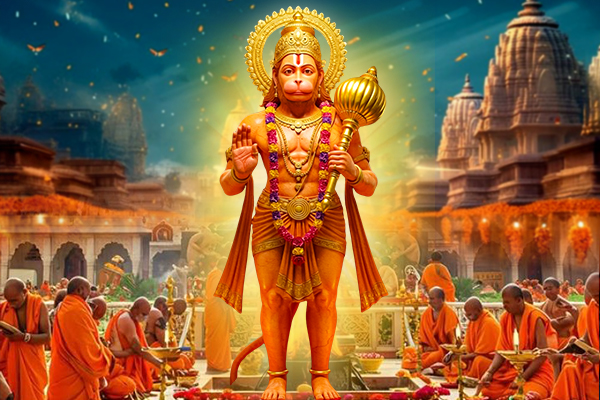
Many devotees visit Hanuman temples, which are often beautifully decorated for the occasion. In some regions, such as Maharashtra, spiritual discourses and readings from the Ramayana commence at dawn, as Hanuman is believed to have been born at sunrise. During the birth time, these discourses pause, and prasadam (sanctified food) is distributed to all attendees.
Applying Sindoor and Seeking Blessings
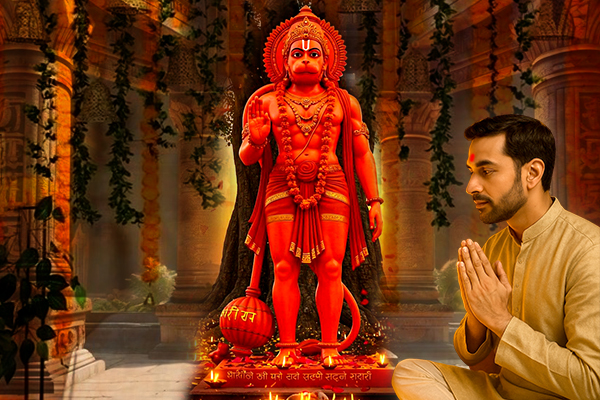
A unique tradition involves applying sindoor to Hanuman's idol and then to one's own forehead. This practice is rooted in a legend where Hanuman, upon learning that Sita applied sindoor for Rama's longevity, smeared his entire body with it to express his devotion. Devotees emulate this act, believing it brings strength and good fortune.
Regional Variations and Extended Observances
In states like Telangana and Andhra Pradesh, Hanuman Jayanti is observed over a 41-day period, starting from Chaitra Purnima and concluding on the tenth day during Krishna Paksha in Vaishakha. Devotees engage in daily rituals, culminating in grand celebrations on the final day.
Cultural Programs and Musical Events
In Varanasi, the Sankat Mochan Sangeet Samaroh is an annual music festival held at the Sankat Mochan Hanuman Temple, featuring performances in Indian classical music and dance. This festival coincides with Hanuman Jayanti and is noted for its free entry and performers not charging any fees, reflecting the spirit of devotion and community participation.
By engaging in these practices, devotees aim to internalize Hanuman's virtues, seeking his blessings for courage, wisdom, and unwavering faith. The festival serves as a reminder of the power of devotion and the strength that comes from selfless service.
Hanuman Jayanti Festival Puja Vidhi (Puja Procedure)
.jpg)
Celebrating Hanuman Jayanti, the auspicious occasion marking the birth of Bhagwan Hanuman, involves a series of traditional rituals and offerings designed to honor his devotion, strength, and humility.
Here's a comprehensive guide to performing the Puja Vidhi (worship procedure):
- Purification: Begin by waking up early, preferably during the Brahma Muhurta (approximately 4:00 AM to 6:00 AM). After bathing, wear clean, preferably red or yellow attire, as these colors are considered auspicious for the occasion.
- Altar Setup: In a clean and sanctified area of your home, set up an altar with an idol or image of Bhagwan Hanuman. Decorate the altar with fresh red or yellow flowers, a garland, and place necessary puja items such as incense sticks, a ghee lamp, sandalwood paste, vermilion (sindoor), and offerings like fruits, sweets (preferably besan laddoos or boondi laddoos), and betel leaves.
- Sankalpa (Vow): Initiate the puja by taking a vow to perform it with devotion. Cleanse your right hand with water, then take some water, rice grains (akshata), and flowers in your right hand. Recite the Sankalpa Mantra, expressing your intent to perform the Hanuman Jayanti Puja for the fulfillment of your wishes and the well-being of your family. After reciting, release the water onto the ground, symbolizing the commitment of your vow.
- Avahana (Invocation): With folded hands, invoke Bhagwan Hanuman to be present during the puja. Visualize his divine form and recite appropriate mantras to invite him into the idol or image placed on the altar.
- Dhyana (Meditation): Meditate upon Bhagwan Hanuman's virtues and exploits. Chant the Hanuman Dhyana Mantra, focusing your mind on his divine attributes and seeking his blessings.
- Offering Asana (Seat): Offer a symbolic seat to Bhagwan Hanuman by placing a few flowers before the idol, accompanied by the appropriate mantra, inviting him to be seated.
- Padya (Washing of Feet): Offer water to Bhagwan Hanuman's feet, symbolically cleansing them, while reciting the corresponding mantra.
- Arghya (Offering): Present an offering of water mixed with sandalwood paste, flowers, and rice to Bhagwan Hanuman, reciting the relevant mantra.
- Achamana (Sipping Water): Offer water for symbolic sipping, purifying the deity, accompanied by the appropriate mantra.
- Snana (Bathing the Deity): Panchamrita Snana: Bathe the idol with a mixture of milk, curd, honey, ghee, and sugar, known as Panchamrita, while chanting the respective mantra.
- Shuddhodaka Snana: Follow this by bathing the idol with pure water, preferably from the Ganges (Ganga Jal), reciting the corresponding mantra.
- Vastra (Clothing) and Upaveeta (Sacred Thread): After the bath, dress the idol in new clothes, typically a red or orange cloth, and offer a sacred thread (Yajnopavita), accompanied by the relevant mantras.
- Anointment with Sindoor and Oil: Apply a paste of vermilion (sindoor) mixed with jasmine oil to the idol, a practice rooted in the legend where Hanuman covered himself in sindoor for Bhagwan Rama's well-being.
- Application of Sandalwood Paste and Akshata: Apply sandalwood paste to the forehead of the idol and offer unbroken rice grains (akshata), reciting the appropriate mantras.
- Pushpa (Flower Offering): Offer fresh flowers and garlands to the deity, accompanied by the relevant mantra.
- Dhupa (Incense) and Deepa (Lamp): Light incense sticks and a ghee lamp, waving them in a circular motion before the idol while chanting the respective mantras.
- Naivedya (Food Offering): Present the prepared offerings, such as besan laddoos, boondi laddoos, fruits, and a mixture of roasted chickpeas and jaggery, to Bhagwan Hanuman, reciting the corresponding mantra.
- Tambula (Betel Leaves) and Dakshina (Monetary Offering): Offer betel leaves with areca nut and a small monetary donation, accompanied by the appropriate mantras.
- Aarti (Devotional Song): Conclude the puja by performing the Hanuman Aarti, singing praises of Bhagwan Hanuman while waving the ghee lamp in a circular motion.
- Pradakshina (Circumambulation) and Pranama (Prostration): Perform circumambulation of the altar three times in a clockwise direction and offer prostrations to Bhagwan Hanuman, seeking his forgiveness for any mistakes during the puja and his continued blessings.
- Distribution of Prasadam: After the completion of the puja, distribute the offered food (prasadam) among family members and devotees, sharing the blessings of Bhagwan Hanuman.
By following this Puja Vidhi with sincerity and devotion, devotees honor Bhagwan Hanuman and seek his divine blessings for strength, courage, and protection.
Hanuman Jayanti Puja Mantras
Observing Hanuman Jayanti involves performing specific rituals and reciting mantras to honor Bhagwan Hanuman. Below is a selection of significant mantras commonly chanted during the puja:
Hanuman Moola Mantra
This foundational mantra is recited to invoke Bhagwan Hanuman's blessings.
ॐ श्री हनुमते नमः॥
Om Shri Hanumate Namah
Hanuman Gayatri Mantra
This mantra seeks Bhagwan Hanuman's guidance and enlightenment.
ॐ आञ्जनेयाय विद्महे वायुपुत्राय धीमहि।
तन्नो हनुमत् प्रचोदयात्॥
Om Anjaneyaya Vidmahe Vayuputraya Dhimahi।
Tanno Hanumat Prachodayat॥
Hanuman Dhyana Mantra
This mantra is used during meditation to focus on Bhagwan Hanuman's virtues.
कर्णिकारसुवर्णाभं वर्णनीयं गुणोत्तमम्।
अर्णवोल्लङ्घनोद्युक्तं तूर्णं ध्यायामि मारुतिम्॥
Karnikara Suvarnabham Varnaniyam Gunottamam।
Arnavollanghanodyuktam Turnam Dhyayami Marutim॥
Hanuman Asana Mantra
This mantra is chanted while offering a seat to Bhagwan Hanuman during the puja.
नवरत्नमयं दिव्यं चतुरस्रमनुत्तमम्।
सौवर्णमासनं तुभ्यं कल्पये कपिनायक॥
Navaratnamayam Divyam Chaturasramanuttamam।
Sauvarnamasanam Tubhyam Kalpaye Kapi Nayaka॥
Hanuman Aarti
Concluding the puja with the Aarti is customary, expressing reverence and seeking Bhagwan Hanuman’s blessings.
आरती कीजै हनुमान लला की।
दुष्ट दलन रघुनाथ कला की॥
Aarti Kijai Hanuman Lala Ki।
Dushta Dalan Raghunath Kala Ki॥
These mantras are integral to the
Hanuman Jayanti Puja
, each serving a unique purpose in venerating Bhagwan Hanuman.
Note: It's advisable to learn the correct pronunciation and understanding of these mantras, possibly under the guidance of a knowledgeable person, to perform the puja with proper devotion.
Hanuman Chalisa
The Hanuman Chalisa is a revered Hindu devotional hymn composed by the poet-saint Tulsidas in the 16th century. It consists of 40 verses (Chalisa) that praise the virtues, strength, and devotion of Bhagwan Hanuman, who is celebrated for his unwavering dedication to Bhagwan Rama. Reciting the Hanuman Chalisa is believed to invoke divine protection, courage, and wisdom.
Opening Invocation (Doha):
With the dust of the Guru's lotus feet, I cleanse the mirror of my mind and narrate the sacred glory of Bhagwan Rama, the supreme among the Raghu dynasty, bestowing the four fruits of life (dharma, artha, kama, moksha).
Considering myself devoid of wisdom, I meditate upon you, Son of the Wind, to grant me strength, wisdom, and knowledge, and to remove my afflictions and impurities.
Main Verses (Chaupai):
- Victory to Hanuman, the ocean of wisdom and virtue, illuminator of the three worlds.
- Messenger of Rama, repository of immeasurable strength, son of Anjani and known as the son of the wind.
- Great hero, mighty as a thunderbolt, dispeller of wickedness, companion of the good.
- Golden-hued, splendidly adorned, wearing earrings with curly hair.
- Holding the mace and flag in your hands, sacred thread adorning your shoulder.
- Incarnation of Shiva, son of Kesari, your glory is revered throughout the world.
- Learned, virtuous, and exceedingly wise, ever eager to perform Rama's tasks.
- Delighting in hearing of Rama's deeds, you dwell in the hearts of Rama, Lakshmana, and Sita.
- Assuming a subtle form, you appeared to Sita; in a formidable form, you burned Lanka.
- In a terrifying form, you destroyed demons, fulfilling the work of Bhagwan Rama.
- You brought the life-restoring herb to revive Lakshmana, earning Rama's embrace in joy.
- Rama praised you greatly, declaring you as dear to him as his brother Bharata.
- The thousand-headed Shesha sings your glory; even sages like Sanaka and Brahma cannot fully describe your virtues.
- Yama, Kubera, and the guardians of the directions sing your praise; how can poets and scholars fully describe your glory?
- You aided Sugriva, introducing him to Rama, thereby granting him kingship.
- Vibhishana heeded your counsel, becoming the Bhagwan of Lanka, known throughout the world.
- Traversing the sky, you swallowed the sun, mistaking it for a sweet fruit.
- Holding Bhagwan Rama's ring in your mouth, you leaped across the ocean; no wonder, considering your greatness.
- All difficult tasks in the world become easy with your grace.
- You are the guardian at Rama's door; without your consent, no one can enter.
- All comforts are attainable through your refuge; when you are the protector, there is nothing to fear.
- Your radiant energy pervades the three worlds; all beings tremble at your mighty roar.
- Evil spirits and ghosts do not come near when your name is chanted, O Mahavir.
- Diseases and pains are eradicated, and all sufferings vanish when one remembers the mighty Hanuman.
- Those who contemplate upon you with mind, action, and words are freed from all crises by Hanuman's grace.
- You are the protector of sages and saints, the destroyer of demons, and dear to Rama.
- You can bestow the eight siddhis (supernatural powers) and the nine nidhis (types of wealth) as granted by Mother Sita.
- You hold the essence of devotion to Rama, remaining his eternal servant.
- Through your devotion, one gains Rama's grace and forgets the sorrows of countless lifetimes.
- At life's end, one who remembers you goes to Rama's abode and is reborn as a devotee.
- Even other deities do not captivate the mind; all happiness is found in serving Hanuman.
- All difficulties and pains are removed for those who meditate upon the powerful Hanuman.
- Hail, hail, hail to you, O Bhagwan Hanuman! Bless us as our supreme teacher.
- One who recites this Chalisa a hundred times is released from bondage and enjoys supreme bliss.
- Those who read the Hanuman Chalisa attain perfection, as witnessed by Bhagwan Shiva himself.
- Tulsidas, ever the servant of Hari, prays for Hanuman to reside in his heart.
Concluding Invocation (Doha):
O Son of the Wind, remover of all difficulties, embodiment of auspiciousness, reside in my heart along with Rama, Lakshmana, and Sita.
Reciting the Hanuman Chalisa with devotion is believed to bring strength, wisdom, and relief from afflictions. It serves as a powerful tool for spiritual upliftment and connection with Bhagwan Hanuman's divine energy.
For a musical rendition with English lyrics and meanings, you might find this video helpful:
Hanuman Jayanti Vrat Vidhi (Fasting Procedure)
Observing a fast (Vrat) on Hanuman Jayanti is a significant practice among devotees, symbolizing devotion and seeking blessings from Bhagwan Hanuman.
Below is a comprehensive, step-by-step guide to the Vrat Vidhi (fasting procedure):
Preparation Before the Fast
- Brahmacharya Observance: Maintain celibacy and purity in thoughts and actions during the fasting period.
- Sleeping Arrangements: On the eve of Hanuman Jayanti, sleep on the floor as a mark of humility and devotion.
Early Morning Rituals
- Pre-Dawn Awakening: Rise during the Brahma Muhurta (approximately 4:00 AM to 6:00 AM).
- Remembrance: Begin the day by remembering Bhagwan Rama, Goddess Sita, and Bhagwan Hanuman.
- Purification: Take a bath to cleanse the body and wear clean, preferably red or yellow, attire.
Sankalpa (Vow) for the Fast
Declaration: With water in hand, take a vow to observe the fast with sincerity and devotion, seeking Bhagwan Hanuman's blessings.
Setting Up the Puja Altar
- Altar Placement: In a clean area facing east, place a wooden platform covered with a new yellow cloth.
- Idol Placement: Position an idol or image of Bhagwan Hanuman on the prepared platform.
Puja (Worship) Rituals
- Lighting the Lamp: Illuminate an oil or ghee lamp near the idol.
- Abhishekam (Anointment): If the idol is metallic, perform an abhishekam using raw milk, water, honey, ghee, and curd.
- Offerings: Present fresh red or yellow cloth, sacred thread (Janeu), sandalwood paste, incense sticks, and flowers to the deity.
- Mantra Recitation: Chant the Hanuman Mool Mantra, Hanuman Chalisa, and other Hanuman Stotras with devotion.
- Naivedya (Food Offering): Offer fruits, a sattvic meal, or Tamboolam (betel leaves, coconut, supari, banana, dakshina, and fruits).
- Aarti: Perform the Aarti by singing the Hanuman Aarti and circling the camphor flame in front of the idol.
Observing the Fast
- Dietary Restrictions: Abstain from consuming salt and grains.
- Permissible Intake: Consume fruits, milk, and other non-grain foods if needed.
- Mental Discipline: Maintain a positive and devotional mindset throughout the day.
Breaking the Fast (Vrat Parana)
- Evening Puja: In the evening, perform a concluding puja to Bhagwan Hanuman.
- Meal Post-Fast: After the evening rituals, break the fast by consuming wheat-based items like puri, paratha, or halwa, ensuring that salt is still avoided.
By meticulously following this Vrat Vidhi, devotees honor Bhagwan Hanuman and seek his divine blessings for strength, wisdom, and protection.
Hanuman Jayanti Vrat Katha (Traditional Fasting Story)
.jpg)
In the celestial realms, where the forces of light and darkness constantly battled, a divine prophecy was set into motion. The gods foresaw the rise of Ravana, the mighty demon king of Lanka, whose tyranny and unchecked power would threaten the balance of the universe. To counteract this growing evil, Bhagwan Shiva decided to take an earthly form, destined to serve Bhagwan Vishnu’s avatar, Bhagwan Rama. This incarnation of divine strength, devotion, and unwavering courage would come to be known as Hanuman.
The Curse and the Divine Boon
Once upon a time, in the heavenly abode, a beautiful celestial nymph named Punjiksthala enjoyed a carefree existence. However, due to a moment of arrogance, she was cursed to be reborn as a Vanara (monkey-like being) on Earth. In her new form, she became Anjana, a devoted woman who tirelessly prayed to Bhagwan Shiva for redemption. Seeing her intense penance, Bhagwan Shiva blessed her, saying that her curse would be lifted once she gave birth to an incarnation of his divine energy.
Meanwhile, in Ayodhya, King Dasharatha was performing a Putrakameshti Yagna, a sacred ritual to be blessed with children. At the end of the ritual, a divine pudding (payasam) emerged from the sacred fire, which he distributed among his wives. At this moment, Vayu Deva (the Wind God), acting upon Shiva’s divine will, carried a portion of this sacred offering to Anjana. Upon consuming it, she conceived a child who would be blessed with immeasurable strength, intelligence, and immortality.
The Birth of Hanuman
On an auspicious day, Anjana gave birth to a radiant child, his form glowing like molten gold, his eyes gleaming with celestial light. He was no ordinary child—he was the embodiment of devotion, might, and divine wisdom. As soon as he was born, the forests of Kishkindha resonated with divine chants, flowers rained from the heavens, and the Devas rejoiced. The child was named Hanuman, meaning “one with a strong jaw,” a name that would soon prove its significance.
Hanuman’s Mischievous Childhood and the Cosmic Turmoil
As Hanuman grew, his curiosity and boundless energy often led him into playful mischief. One fateful morning, he gazed upon the rising sun, glowing like a ripe fruit, and his childlike mind believed it to be something delicious. With one mighty leap, he soared towards the sky, determined to seize it.
As he neared the celestial sphere, the gods were alarmed. The great Sun God, Surya Deva, shone even brighter, attempting to ward off the young Vanara. Fearing that Hanuman’s unchecked power could disrupt cosmic harmony, Bhagwan Indra, the king of gods, intervened and struck him with his Vajra (thunderbolt), causing him to plummet to the ground unconscious.
Seeing his beloved son wounded, Vayu Deva was consumed with grief and anger. In his sorrow, he withdrew all air from the universe, causing the entire world to suffocate—rivers stopped flowing, leaves withered, and creatures gasped for breath. Witnessing the destruction, Bhagwan Brahma, Bhagwan Vishnu, and all celestial beings rushed to pacify Vayu.
To restore cosmic balance, each god granted Hanuman powerful boons:
- Brahma blessed him with the ability to become as large as a mountain or as small as an atom.
- Vishnu gave him invincibility and divine wisdom.
- Indra granted him immunity from his Vajra (thunderbolt) and made his body stronger than diamond.
- Agni (the Fire God) ensured that fire would never harm him.
- Varuna (the Water God) made him immune to drowning.
- Kala (Time) blessed him with immortality, ensuring he would live for eternity.
With these blessings, Hanuman awoke, fully healed and mightier than ever, unaware that he had just been gifted power beyond even the gods.
Hanuman’s Eternal Devotion to Bhagwan Rama

Though endowed with celestial powers, Hanuman’s true strength lay in his devotion (Bhakti) to Bhagwan Rama. As destiny unfolded, he met Bhagwan Rama and Lakshmana at Rishyamukha, a meeting that would define his eternal purpose. The moment he set eyes on Bhagwan Rama, his soul recognized its divine master. He knelt before Rama, vowing eternal servitude, and from that day forth, his life’s only mission was to serve his Bhagwan.
From locating Sita in Lanka, to setting Ravana’s golden city ablaze, to carrying the entire Dronagiri Mountain to save Lakshmana, Hanuman proved himself the ultimate warrior of righteousness and the embodiment of unwavering devotion.
Significance of Hanuman Jayanti Vrat Katha

This sacred story is recited on Hanuman Jayanti to remind devotees of faith, courage, and selfless service. Fasting on this day is believed to:
- Remove obstacles and negative energies.
- Grant physical and mental strength.
- Bring divine protection and success in endeavors.
- Bestow wisdom, devotion, and unwavering faith in God.
Hanuman Jayanti is a reminder that true strength lies in humility, devotion, and selfless service. By reciting his story, fasting, and chanting the
Hanuman Chalisa
, devotees invite his divine blessings into their lives.
Even today, Hanuman is said to be present wherever Bhagwan Rama’s name is chanted, fulfilling his final promise that as long as Rama’s name is remembered, he will remain on Earth, protecting his devotees.
Jai Bajrang Bali! Jai Hanuman!
Puja Utensils, Essentials
Rudra Centre brings an extensive collection of Puja Articles which caters to all that is required for daily and special Puja Vidhis. We offer variants of designs and sizes in each category. The list includes handcrafted Puja Mandirs, Puja Pedestals, offering Bowls, Panchpatra, intricately carved Puja Thalis, Abhishek Vessels, in different materials, Pure Silver/German Silver articles like Kalash, set of Shodash Upachara and Several other Puja Articles, which we deliver at your doorstep.
Visit the complete collection:
14 Mukhi Java 925 Silver Caps Mala

The 14 Mukhi Rudraksha ruled by Bhagwan Hanuman helps in brining solution to problems, courage to face challenges, bravery, will power, passion, control over makes decision making easier, enhances intuitive powers, helps to recognize one's potential and talents. Therapeutically 14 Mukhi Rudraksha supports in healing bones, arthritis, disorders of the nervous system and heals trauma. Sandalwood beads help to heal joint pains, digestive system disorders, skin itching or inflammation etc. The 14 Mukhi Java Mala helps to heal individuals who are suffering from any of these diseases or ailments too. The genuine, natural 14 Mukhi Java Mala is recommended for victory, excellence, balance, good health and calmness.
14 Mukhi Rudraksha Bracelets
Our bracelets are specially handcrafted as per our unique stinging method in accordance to Vedic knowledge. They can be worn regularly as spiritual accessory for deriving optimum benefits of the beads. 14 Mukhi Rudraksha is governed by Bhagwan Hanuman and blesses the wearer with willpower, courage, victory, fearlessness and helps him/her identify their latent potential. It helps pacify malefic of Mars and Saturn and attain success, victory and excellence.
Hanuman Idols

A charming collection of meticulously crafted Bhagwan Hanuman gemstone idols infused with gemstone energies. These idols depict Hanuman in seated, kneeling, meditating, and other poses of varying significance. Crafted by skilled artisans, each idol is meticulously crafted from 100% natural and non-heated gemstone to provide the best benefits of the gemstones as well as the Deity's blessing.
Siddh Meru Hanuman Yantra

This Yantra is magnificently crafted in elevated three dimensional form in pure copper with antique finish. This Yantra is designed as per authentic texts with accurate geometry of 8 petal lotus at the base followed by a circle leading to another circle with crescent cut on two sides for the convergence of the individual soul with divine energy of Bhagwan Hanuman.
Bhagwan Hanuman Pendants

Embrace protection with our Bhagwan Hanuman Pendants skillfully crafted in pure Silver, Gold, and Parad (Mercury). Depicting Bhagwan Hanuman carrying the Sumeru Mountain or sitting with folded hands, these pendants provide physical and mental strength, courage, victory over challenges, and protection from evil. Suitable for all age groups, wear them and share them as powerful gifts.
Hanuman Puja (Puja for Protection and Valor)
Hanuman Puja is performed to seek the divine blessings of Bhagwan Hanuman, who represents strength, protection, and devotion. Bhagwan Hanuman is a powerful deity who removes fear, negativity, and malevolent influences. He is revered for his unwavering courage and ability to overcome obstacles. This puja is especially beneficial to those looking for physical and mental strength and protection.
Benefits of Online Hanuman Puja
- Provides protection from enemies, evil spirits, and negative energies
- Instills courage, confidence, and fearlessness
- Removes obstacles in personal and professional life
- Grants physical and mental strength
Rudra Centre Puja Services is the oldest and most trusted Online Puja Services provider in the world. Over 20 years we have organized Yagnas, Pujas, Homas and Kathas like Ati Rudra Mahayajna, Sahasra Chandi Homa, Akhand Ramayan Paath, Shiva Maha Puran Katha, 4 Prahar Mahashivratri Mahapuja with teams of 100’s of curated priests for the benefit of mankind and our global clientele.
Conclusion
Hanuman Jayanti is a sacred celebration of faith, resilience, and unwavering devotion. It is a day when millions come together to honor the mighty Hanuman, the immortal guardian of righteousness, whose unparalleled strength, boundless wisdom, and supreme humility continue to inspire generations. From the epic battlefields of the Ramayana to the hearts of countless devotees, Hanuman remains a symbol of selfless service and indomitable courage.
This festival is not just about rituals and prayers; it is an opportunity to reflect on Hanuman’s divine virtues and incorporate them into our own lives. His unbreakable faith in Bhagwan Rama, his fearless determination against all odds, and his unparalleled humility despite possessing celestial powers teach us the true meaning of devotion and righteousness. Every chant of the Hanuman Chalisa, every act of seva (selfless service), and every moment of fasting on this day connects devotees to his divine presence, drawing them closer to the eternal truth that Hanuman himself embodies.
But the power of Hanuman Jayanti does not end with the day’s celebrations. Hanuman is Chiranjivi (immortal), and his presence is felt wherever Bhagwan Rama’s name is chanted. He lives in the courage of those who face adversity, in the faith of those who surrender to the divine, and in the service of those who dedicate their lives to dharma. As we bow before Bajrang Bali, may we invoke his strength in our struggles, his wisdom in our decisions, and his devotion in our hearts.
With every “Jai Bajrang Bali!”, we awaken the Hanuman within us—the fearless, the faithful, and the unshakable. May his blessings protect, guide, and uplift us on our journey toward truth, righteousness, and divine grace.
Jai Hanuman! Jai Shri Ram!

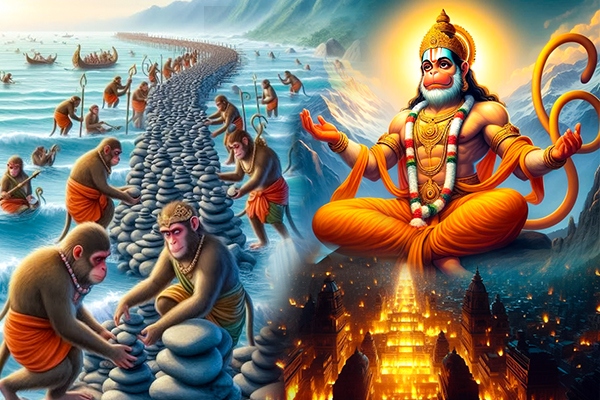
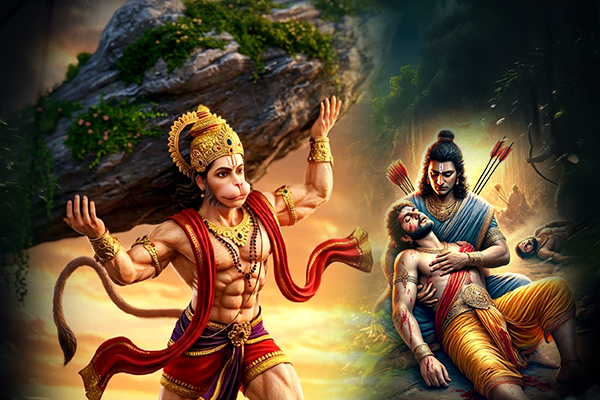
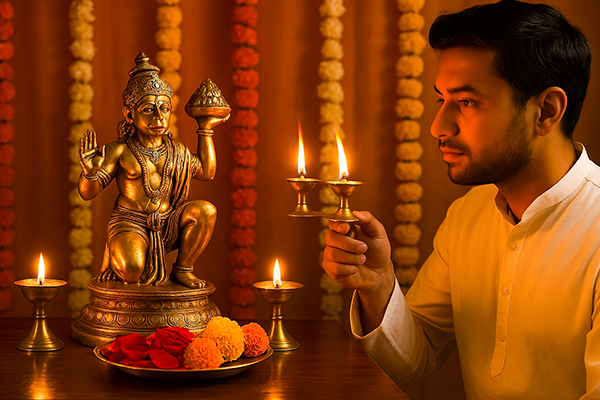
.jpg)

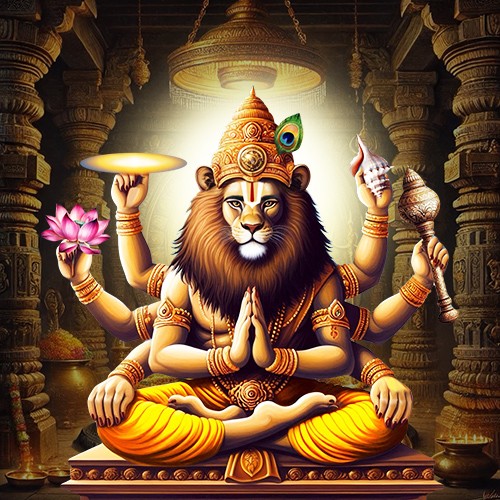
-in-Astrology.jpg)
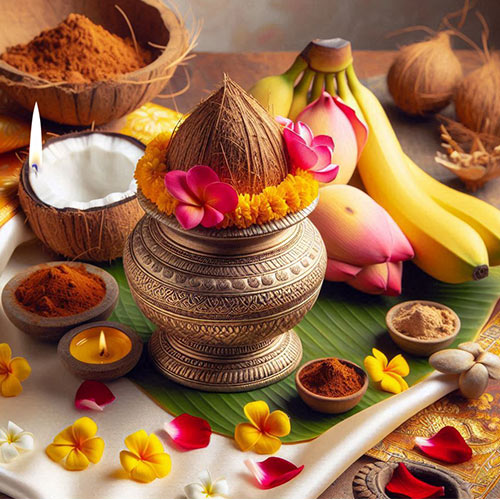



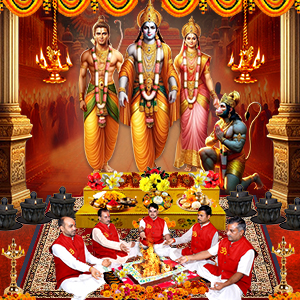
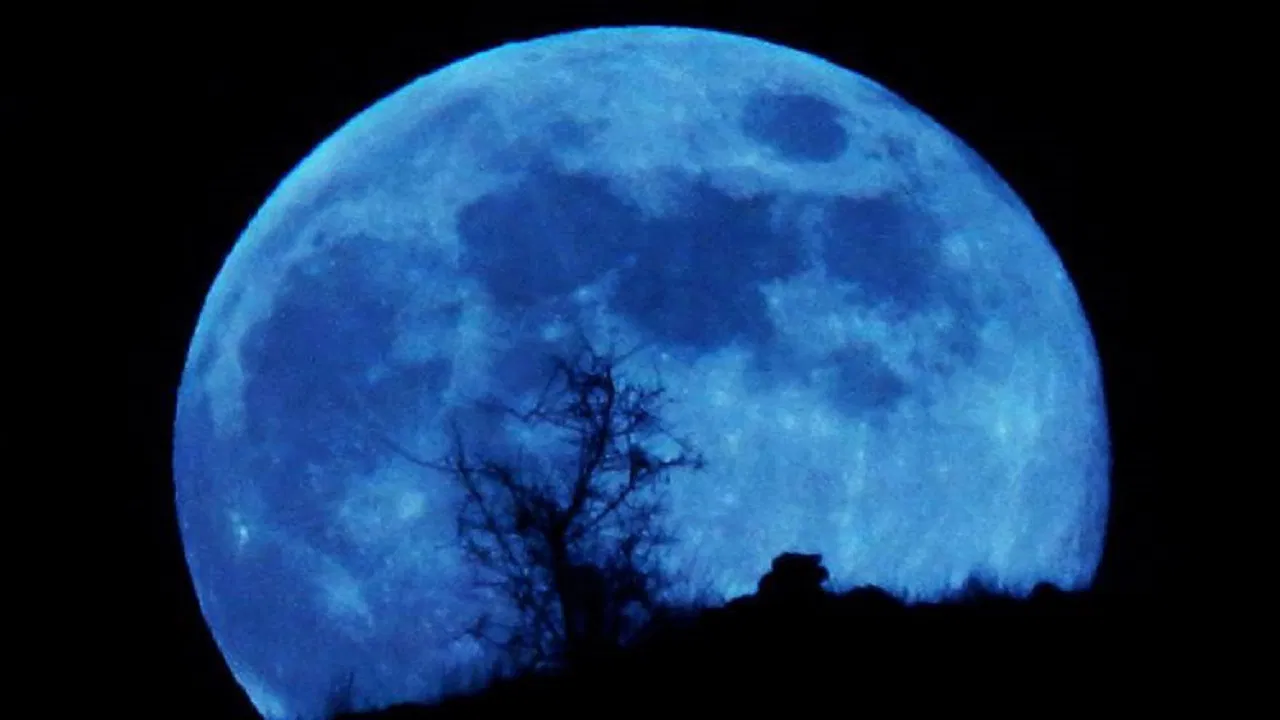

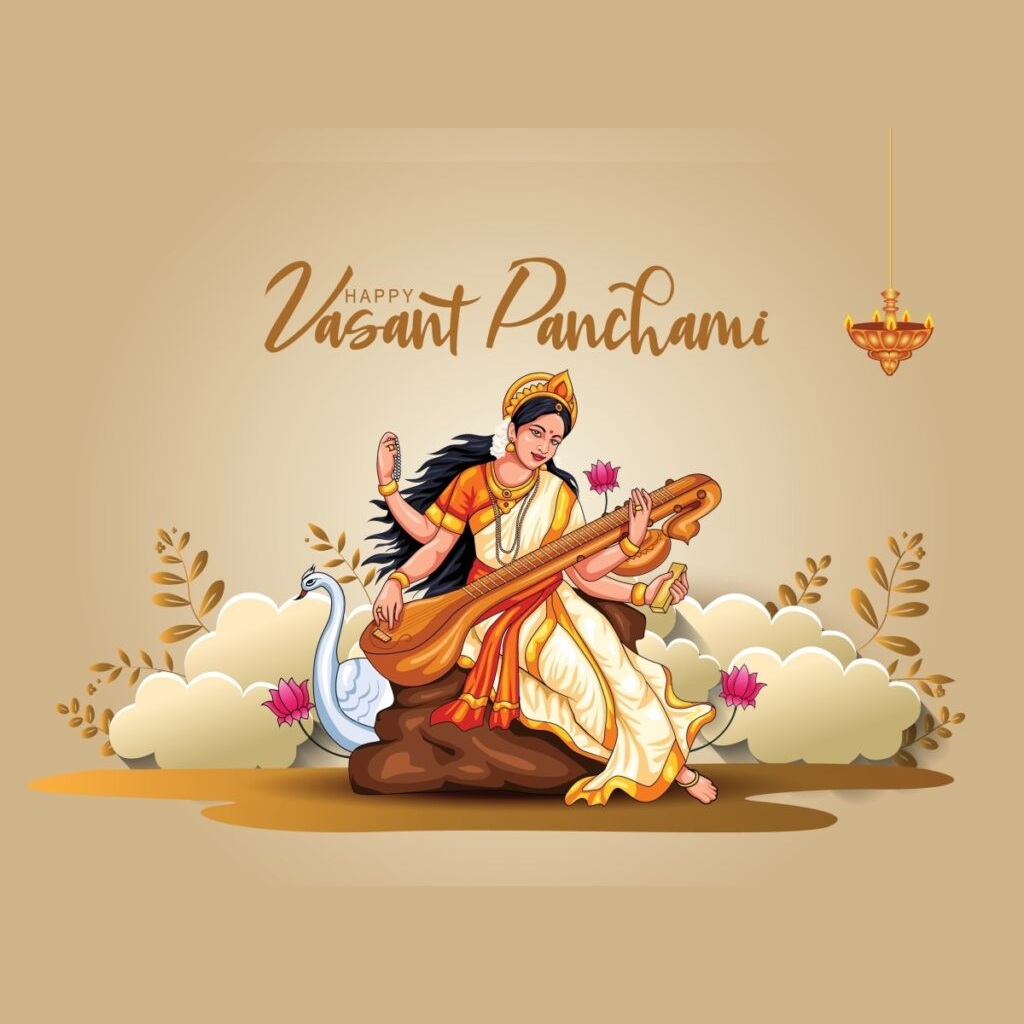
Comments 0
Leave your thought here